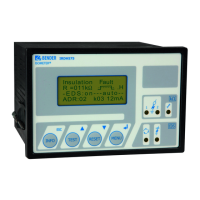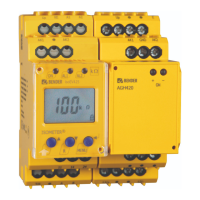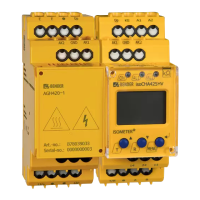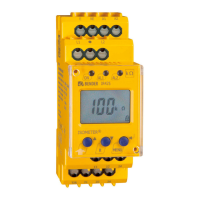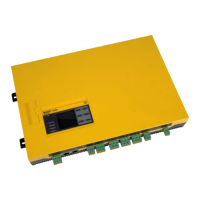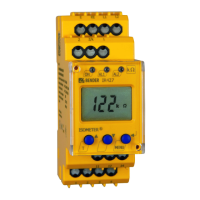Function
21
isoRW425_D00052_03_M_XXEN / 02.2017
The measuring pulse is produced by the measuring pulse generator integrat-
ed in the ISOMETER® . The measuring times for C
e
, U
L1e
, U
L2e
and R % are syn-
chronous. System disturbances may lead to extended measuring times. In
contrast, the time for the system voltage measurement U
n
is independent and
considerably shorter.
In Z mode a fixed and short measuring pulse time is applied, leading to a short
measuring time for all measured values.
Total response time t
an
The total response time t
an
is the sum of the operating time t
ae
and the
on-delay time t
on
.
Operating time t
ae
The operating time t
ae
is the time required by the ISOMETER® to determine
the measuring value. The insulation resistance measuring value depends on
the the insulation resistance and the leakage capacitance. For example, a
maximum permissible leakage capacitance of C
e
= 300 µF and an insulation
fault of R
F
= 2.5 k (R
an
= 5 k) in a 400 V DC system results in an operating
time of t
ae
< 40 s.
High leakage capacitances and system interferences lead to longer operating
times.
Response delay t
on
The response delay t
on
is set uniformly for all messages in the menu "t" using
the parameter "ton". This delay time can be used for interference suppression
in the case of short measuring times.
An alarm will only be signalled when a threshold value of the respective meas-
uring value is violated for the period of t
on
without interruption. Every time
the threshold value is violated within the time t
on
, the response time "ton" re-
starts once again. Every alarm message listed in the alarm assignment has its
own timer for t
on
.
Delay-on release t
off
The delay-on release t
off
can be set uniformly for all messages in the menu "t"
using the parameter "toff".
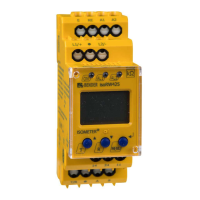
